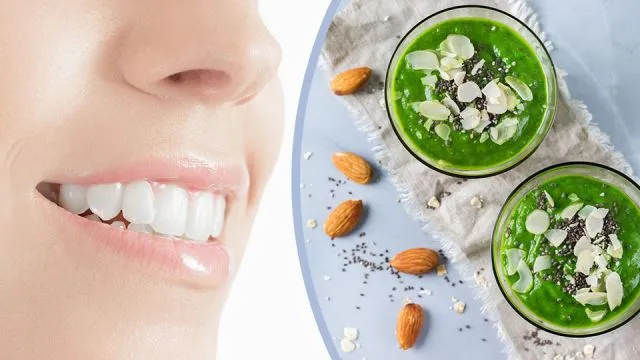
- Share on Facebook113
- Share on Pinterest
- Share on Twitter
I still remember the excitement of losing my first couple of teeth (and waking up to a Canadian two dollar bill). Yes, I’m dating myself here because those brown bills were replaced by the “Toonie” in 1996.
Anywho, I remember my mom explaining to me, “Krista, the teeth that will grow in next are for life. You have to take care of them so that you can keep your pretty smile.”
As a kid, a lifetime seems like, well, forever — and now that I’m older, am I ever happy that my mom taught me about the importance of good oral health early on. With not a single dental filling in my mouth, there is one area I have been concerned with in recent years — the calcium content of my teeth, as well as the protective enamel that contributes to a whiter, brighter smile.
Why should we care about tooth demineralization?
When you get a cavity, you get it filled — because teeth cannot regenerate, right?
Well, not exactly. The truth is, your teeth are very much alive, hard at work just like any other part of your body. With numerous components, including the dentin, enamel, and periodontal ligament, diet has a lot more to do with your oral health than you may have initially believed.
Although a complex process, certain minerals are required in order to maintain the health of your teeth. These mainly include calcium, phosphorus, magnesium, and iron. This is why many experts agree that cavities are actually a diet issue — not an oral hygiene problem.
Of course, our teeth are hard — but they’re not a stonelike structure. In fact, teeth are more like sponges. They allow nutrients to flow in and out. This is why as long as you are gaining minerals (known as remineralization) more rapidly than you are losing minerals (demineralization), you will be able to stave off tooth decay.
Just some of the foods that cause demineralization include processed foods, high-sugar foods, bread, soda, and sugary yogurt. In comparison, some of the best foods for your teeth in terms of remineralization are eggs, grass-fed cheese and butter, wild-caught fish, dark leafy greens, avocado, green tea, celery and apples.
How to recalcify and re-enamel your teeth
As mentioned above, your teeth are porous. This means that the outer surface is covered with small, innumerable holes. Just as minerals can enter, so can a wide range of other substances. This is also why smoke and coffee are able to stain teeth. When optimal levels of phosphate, calcium, and other key minerals are found in the saliva, they effectively harden your enamel.
Although your enamel cannot be rebuilt once lost, you can actively repair and strengthen the enamel you currently have. As long as erosion has not caused your tooth enamel to disappear completely, it can be repaired — which is where dental remineralization comes into play.
In order to recalcify and in turn, re-enamel, focus on the following.
1. Start with your diet
Remember, a balanced diet is number one in regards to optimal oral health. As stated in Dr. Weston A. Price’s book, Nutrition and Physical Degeneration, cultures who have no access to modern dental care or toothpaste were able to completely avoid tooth decay. Their secret? A primitive diet.
Related: Can Eating the Right Foods Reverse Tooth Cavities?
For starters, you should be eating a whole food diet void of processed food (especially starchy, high-sugar items), ensuring that you get enough calcium. Some of the best sources include but are not limited to spinach, okra, kale, sardines, chia seeds, yogurt, beans, and almonds. Fat-soluble vitamins are also crucial, including vitamins A, D, E and K.
2. Supplement vitamin D
If you believe you are vitamin D deficient, it is important to supplement this crucial nutrient. Those who avoid dairy, are vegan, or do not get a lot of sun are all at risk. Since the absorption of calcium and phosphorus depend on vitamin D, you will not effectively recalcify without it.
Although you should spend at least 15-20 minutes outside daily, you can also focus on more vitamin D-rich food sources. For example, eating a 6-8 ounce piece of mackerel or salmon daily will do the trick. This vitamin is also found in egg yolks, cheese, and beef liver.
3. Brush with a remineralizing toothpaste
If you think a “remineralizing toothpaste” sounds expensive, you’ll be happy to know that you can make your own. There are many recipes online, all of which tend to call for a combination of calcium powder, granulated xylitol, coconut oil, bentonite clay, baking soda, and essential oils.
Related: 6 Scary Reasons to Switch to Natural Toothpaste
4. Reduce your intake of phytic acid
A compound found in plants, phytic acid allows plant tissues to store phosphorus. Although ideal for plants, eating too much phytic acid can reduce the amount of phosphorus that’s available for our own teeth and body. In addition, this acid will bind with magnesium, zinc, and iron, and calcium. Once it does, it forms phytates which significantly affect your body’s ability to absorb these crucial minerals.
Found in seeds, nuts, legumes, and grains, although you can go grain-free, these foods are an important component of a well-balanced diet. That is why it’s recommended that you minimize the risks by sprouting, fermenting, or soaking these foods.
By implementing these recommendations into your routine, you will develop new habits that promote a healthier smile. After all, you only have one set of teeth — take a proactive approach today!
— Krista Hillis
- Share on Facebook113
- Share on Pinterest
- Share on Twitter

